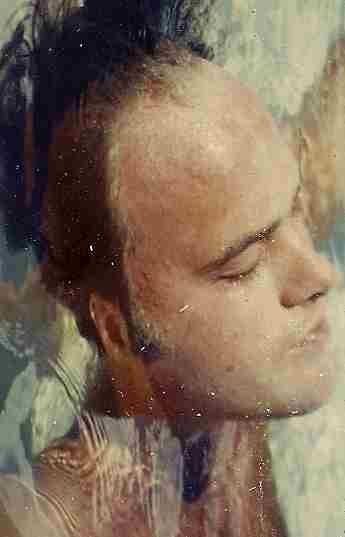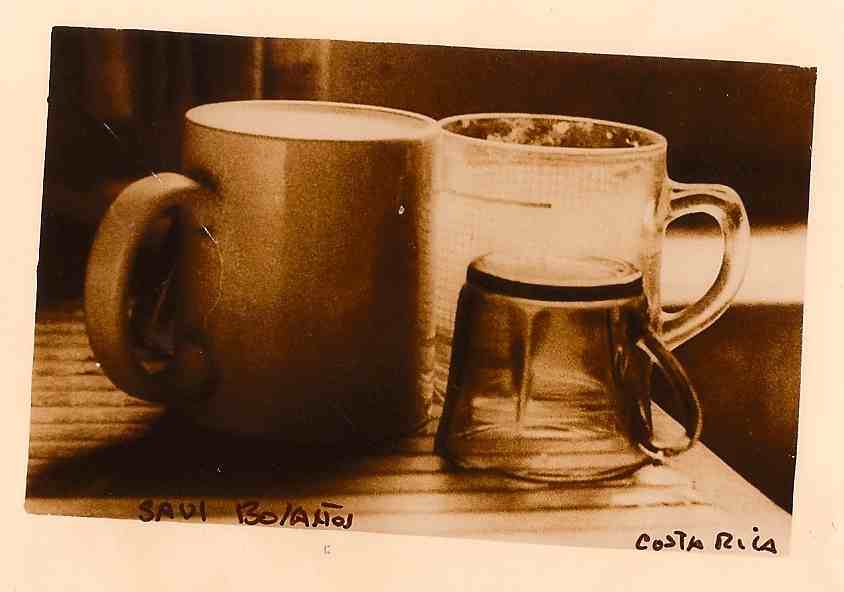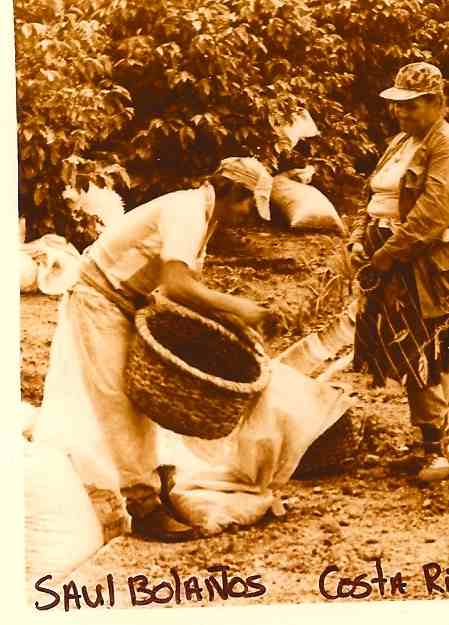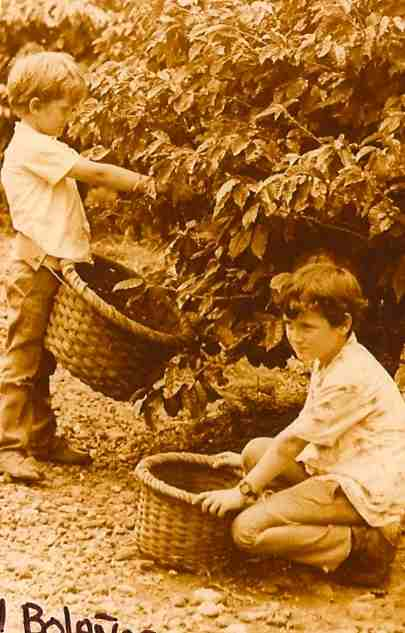the coffee art of
SAUL BOLAÑOS

by
JOHN M. EDWARDS
___________________________________________
 John
Edward's work has appeared in Amazon.com, CNN Traveller,
Missouri Review, Salon.com, Grand Tour, Michigan Quarterly
Review, Escape, Global Travel Review, Condé Nast Traveler,
International Living, Emerging Markets and Entertainment
Weekly. He helped write “Plush” (the opening
chords), voted The Best Song of the 20th Century by Rolling
Stone Magazine.
John
Edward's work has appeared in Amazon.com, CNN Traveller,
Missouri Review, Salon.com, Grand Tour, Michigan Quarterly
Review, Escape, Global Travel Review, Condé Nast Traveler,
International Living, Emerging Markets and Entertainment
Weekly. He helped write “Plush” (the opening
chords), voted The Best Song of the 20th Century by Rolling
Stone Magazine.
A
MODERN DAY ALCHEMIST
Costa
Rica, a coffee democracy in a sea of banana republics, is
known more for its number-one export than its art. It’s
only natural then that the Costa Rican photographic artist
Saul Bolaños decided to fuse the two and extract art
from the ubiquitous bean. His patented cafegrafia ™
(coffee graphics), photo images made real by coffee, explore
the offbeat flight paths of Central American visual art.
 Bolaños’s
process is quite revolutionary for a nonrevolutionary republic.
Using both powdered and liquid coffee as a pigment to make
up a photo image -- instead of the standard silver emulsion
-- he has at the same time developed a special secret chemical
process to make the images absolutely permanent.
No darkroom is needed. Developing an image can be accomplished
in full sunlight. Having previously treated a surface of a
variety of media (paper, glass, wood, ceramic, and stone)
for imaging, Bolaños simply strokes it with coffee,
using a brush, and presto! The subject magically appears.
Bolaños’s
process is quite revolutionary for a nonrevolutionary republic.
Using both powdered and liquid coffee as a pigment to make
up a photo image -- instead of the standard silver emulsion
-- he has at the same time developed a special secret chemical
process to make the images absolutely permanent.
No darkroom is needed. Developing an image can be accomplished
in full sunlight. Having previously treated a surface of a
variety of media (paper, glass, wood, ceramic, and stone)
for imaging, Bolaños simply strokes it with coffee,
using a brush, and presto! The subject magically appears.
In front of the Hotel Gran Costa Rica in the capital San Jose’s
19th-century Plaza de la Cultura -- a bustling marketplace
of manic vendors hawking everything from psychedelic Guatemalan
textiles to Costa Rican T-shirts -- the middle-aged Bolaños
sometimes sells inexpensive cafegrafia to passing tourists.
“To be an artist in Costa Rica is not easy,” says
Bolaños, a self-professed caffeine addict, with a lava-hot
cup of java steaming in one hand. “There are many art
lovers but very few art buyers.”
He
displays what looks like an old photo of a Marquezian nude,
then rubs it, holding up a finger lightly dusted with coffee
grinds. “My favorite is Costa Rican espresso, dark roast,”
he says, by way of explanation, to an amazed onlooker. “I
drink five cups a day. I stop a few weeks each year when it
affects my nerves.”
To Bolaños, the photochemist, Costa Rica is coffee,
and from his laboratory lair in the suburb of Ezcasu, he has
discovered, in the last two decades or so, many things to
do with it besides drink it. The staining properties of coffee
are well known (Bolaños taps his teeth to demonstrate);
the reaction of coffee with certain metallic oxides is not.
“In
1989, I discovered a strange reaction. I made a photo image,
which, after being covered with coffee extracts, reacted outside
of a darkroom -- and the coffee took the place of the image.
The quantity of coffee ‘fixed’ by the image was
in direct proportion to the amount of oxide in the image,
thus giving a perfect gradation of opacities (middle tones)
made up of coffee.” After many years of direct exposure
to sunlight, test images show no evidence of fading, difficult
to achieve even with conventional photo chemicals.
 We
might conclude Bolaños is some kind of alchemist since
he reveals little about he achieves his beautiful golden effect.
“The tones are richer and warmer than any process I
know of, and I know many,” he boasts about his roasts.
We
might conclude Bolaños is some kind of alchemist since
he reveals little about he achieves his beautiful golden effect.
“The tones are richer and warmer than any process I
know of, and I know many,” he boasts about his roasts.
In fact, Bolaños’s magical mystery tour into
the surreal world of coffee art is the result of a lifetime
of research. Born in San Jose, Bolaños spent his boyhood
buzzing around photo studios, surrounded by cameras, lenses
and prints. In 1970, he moved to America and began his professional
career as a photojournalist with a California newspaper. In
1973, he switched to commercial portrait and advertising photography,
while teaching his art on the side and perfecting his craft.
His obsession with the photochemical process then led him
to Europe, where for eight years he haunted laboratories in
Switzerland, France, Germany, England and Italy, pouring like
a nosey Nostradamus over technical literature. A return to
his homeland brought all the ingredients together, and in
1989 he embarked on his research with coffee photography.
 Since
then he has developed five different processes using coffee,
in addition to decaf techniques using other substances like
gold, bronze and quartz. Besides creating and developing a
new medium, the restless innovative wizard Bolaños
has focused his efforts on inventing new technologies, including
a special camera and enlarger. His Faustian laboratory lair
in Ezcasu has the air of a mecca of science as well as a café
of aesthetics, including a library that would make any Merlin
envious and equipment he has either built or modified himself.
Since
then he has developed five different processes using coffee,
in addition to decaf techniques using other substances like
gold, bronze and quartz. Besides creating and developing a
new medium, the restless innovative wizard Bolaños
has focused his efforts on inventing new technologies, including
a special camera and enlarger. His Faustian laboratory lair
in Ezcasu has the air of a mecca of science as well as a café
of aesthetics, including a library that would make any Merlin
envious and equipment he has either built or modified himself.
“If
I lost everything, I’d start all over.” Bolaños
bruits. “Your average photochemist is a flunky for the
company he serves, whereas historically the alchemist was
adept at many crafts. After all, leaving behind a lasting
impression is the next best thing to eternal life.”
So well-versed is he in the technical science of photography
that his discourse often bewilders the amateur shutterbug
and cappuccino quaffer. “After cafegrafia, I developed
orografia, using powdered gold as a pigment. I dissolve gold
in agua regia (nitric and hydrochloric acids), and the resulting
gold chloride is made into a fine metallic powder by adding
ferric salt to the solution. The powdered gold is dried and
used to dust and develop photo images that will accept it.
The images are fixed by gun-spraying them with a varnish.”
Gold images on red crystals were exhibited by Bolanos in the
Costa Rican Museum of Art in 1990.
Bolaños’s newest art is vitrografia, related
to high-temperature chemistry and the properties of quartz.
“In this process, a glazed ceramic piece is covered
with a light-sensitive emulsion and exposed to light by contact
under a positive or a negative. The image is then developed”
--  Bolaños
curls his fingers into Spanish question marks and rolls his
eyes comically like a mad scientist -- “with powdered
quartz and a metallic oxide. The image is then fired in a
chamber until the quartz fuses and ‘vitrifies’
and combines with the glaze.” According to Bolaños,
vitrografia portraits are not affected by gas, water, fire,
acids, or chemicals -- and will last for centuries in the
open air, making them ideal for cemeteries. “This is
only a small part of my research. What I have in my lab now
I cannot publish at this time,” he says with a sly smile.
“Right now it’s all just a curiosity.”
Bolaños
curls his fingers into Spanish question marks and rolls his
eyes comically like a mad scientist -- “with powdered
quartz and a metallic oxide. The image is then fired in a
chamber until the quartz fuses and ‘vitrifies’
and combines with the glaze.” According to Bolaños,
vitrografia portraits are not affected by gas, water, fire,
acids, or chemicals -- and will last for centuries in the
open air, making them ideal for cemeteries. “This is
only a small part of my research. What I have in my lab now
I cannot publish at this time,” he says with a sly smile.
“Right now it’s all just a curiosity.”
Luis Ferrero Acosta, Costa Rica’s best-known art historian,
has called Bolaños “a master;” others say
he is a “witch,” an accusation which he does not
deny.
Since 1990, his work has been the focus of numerous gallery
exhibitions, newspaper and magazine articles, and TV spots
in Latin America. But in the U.S. and abroad his work is still
relatively unknown. Two techniques were featured at the 1993
Photo & Image Expo (Seattle) and the 1993 USA Coffee Show
(Boston). But the international art community (perhaps the
world’s leading coffee consumer) is beginning to wake
up and smell the coffee. At the prestigious 1993 International
Exhibition of Photography (Puyallup, Washington), for example,
Bolaños won medals for two works: “The New Man”
and “The Dreamer” -- the first time Costa Rica
had won in a major international photo competition. The anonymous
entries were judged on artistic merit alone, not other ingredients;
judges remained unaware that Bolaños had maybe slipped
them a little caffeine.
About “The New Man,” a weird self-portrait of
the artist emerging from a giant egg, Bolaños says,
“In the search for myself I grow only when breaking
away from old beliefs. My body dies once but the person within
dies a few times in a lifetime and is transformed.”
Bolaños has refused countless lucrative offers to mass-reproduce
other artists’ work using his strange brew. “I
don’t want art to be like old newspapers in the trashcan.
I didn’t renew my contract with my old agent. I get
by selling my work myself. I won’t get rich this way
but money isn’t everything.” Bolaños smiles
mischievously. “But that doesn’t mean I can’t
entertain serious offers.”
His overpowering eye instead centers on his main addiction,
be it a rural scene of children picking coffee beans or the
traditional coffee-making apparatus in still life, their sepia-like
fresh-brewed textures driving home the fact that Costa Rican
life, outside the tourist districts, hasn’t changed
much in the last century. Other shots range from tranquil
beach and rural scenes and portraits to espresso-like prints
of magical realism involving clowns with balloons and dreamlike
nudes.
Bolaños is now setting his sights and lenses on Big
Apple competitions and exhibitions. “I’ve never
been to New York, but I hear they appreciate good coffee there.”
Where better to bring his caffeinated creations to boil than
among the brave baristas of New York City’s art scene,
Starbucks excepted. “I do not drink or smoke, no religion,
no politics, no sports, no TV. I am extra-sensitive to what
I consume -- but coffee, luckily is still legal. It gets me
going: I like it pure, without fat, sugars and artificial
colorants. His response to skeptical critics: Take art not
with a grain of salt but with a little cream and sugar.